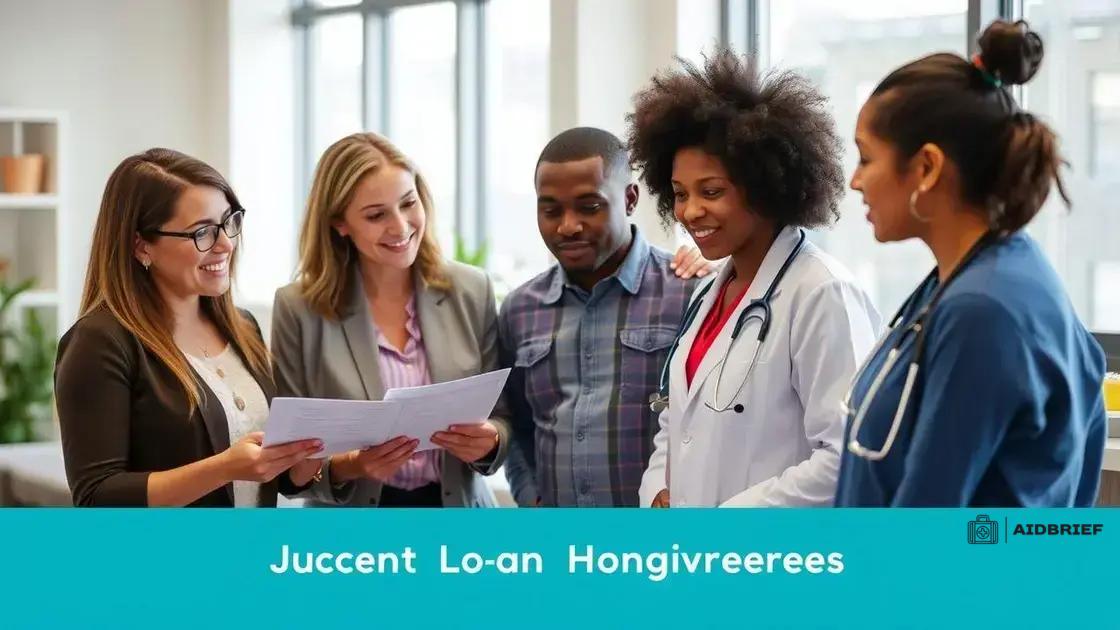Student loan forgiveness: what you need to know

Student loan forgiveness programs can significantly reduce or eliminate federal education debt, but eligibility varies, typically requiring documentation of employment and payment history.
Student loan forgiveness programs are becoming crucial for many borrowers looking to lighten their financial burdens. Have you ever wondered how these programs work and if you qualify? Let’s dive into the essentials of student loan forgiveness and what it could mean for your future.
Understanding student loan forgiveness
Understanding student loan forgiveness can seem daunting at first. However, knowing the essential aspects can help you navigate the process more comfortably. Let’s break down what you need to know.
What is Student Loan Forgiveness?
At its core, student loan forgiveness means that a borrower is no longer required to repay some or all of their loan amount. This relief can be a game changer for many, allowing for a fresh financial start. There are different programs available, each with specific eligibility criteria.
Why is it Important?
The significance of student loan forgiveness lies in its potential to ease financial burdens. Many graduates leave school with considerable debt, making it challenging to manage everyday expenses. Forgiveness programs can provide essential relief by reducing or eliminating this debt.
- Improves financial freedom.
- Encourages graduates to pursue careers in public service.
- Reduces the overall stress related to loan repayment.
Ultimately, understanding how forgiveness works can empower borrowers to make informed decisions about their financial future. Various programs, including federal and state options, offer unique benefits. For instance, some programs require a certain period of employment in public services to qualify for forgiveness. Therefore, knowing these details is vital when approaching forgiveness.
How Does It Work?
The process typically involves applying through a specific program, providing necessary documentation, and meeting eligibility requirements. It’s crucial to stay informed about deadlines and application procedures to avoid missing out on potential benefits. Many borrowers also find the guidance of financial advisors helpful in navigating these applications effectively.
As you explore student loan forgiveness, consider the impacts that qualifying for relief could have on your life. It’s a pathway that can lead to reduced financial stress and open up new opportunities for individuals burdened by educational debt.
Eligibility criteria for forgiveness programs
Eligibility criteria for forgiveness programs are crucial to understand. These programs can provide relief for borrowers, but only if they meet certain conditions. Knowing the requirements can help you avoid potential pitfalls.
General Requirements
To qualify for most forgiveness programs, borrowers typically need to meet specific criteria. These can vary widely depending on the type of program. Here are some common eligibility factors:
- Loan types: Only certain federal loans may qualify.
- Employment status: Many programs require a valid job in specific fields, especially in public service.
- Payment history: A borrower must be in good standing, often making a set number of qualifying payments.
It’s essential to carefully read the terms of each program for details on what is required. Each type of forgiveness program may have unique conditions that could affect your eligibility.
Types of Forgiveness Programs
Various programs are available, catering to different professions and situations. For example, the Public Service Loan Forgiveness (PSLF) program requires borrowers to work in qualifying public sector jobs for a certain period.
Additionally, teachers may benefit from the Teacher Loan Forgiveness program, while healthcare professionals may find relief through specific programs aimed at helping those in the medical field. Knowing the right program for you can significantly impact your financial future.
Keep in mind that documentation is an important part of the process. You may need to provide evidence of employment and payment history. Staying organized can help you streamline your application. The requirements also include regular updates, as guidelines can change, so it’s good to stay informed about any updates related to your chosen forgiveness program.
Types of student loan forgiveness

There are several types of student loan forgiveness programs available, each designed for specific situations and professions. Understanding these options is vital for borrowers looking to reduce their debt burden.
Public Service Loan Forgiveness
The Public Service Loan Forgiveness (PSLF) program is one of the most well-known options. It provides forgiveness after 120 qualifying payments for those working in public service jobs. This means if you work for the government or a nonprofit, you may qualify. It’s essential to confirm that your loans are eligible for this program.
Teacher Loan Forgiveness
For teachers, the Teacher Loan Forgiveness program offers a way to reduce loans after five years of teaching in a low-income school. This program is beneficial for educators who commit to helping underserved communities.
- Eligible teachers may receive up to $17,500 in forgiveness.
- Must teach full-time for five consecutive years.
- Work in an elementary or secondary school that serves low-income students.
This option can significantly ease the financial burden on dedicated teachers.
Income-Driven Repayment Forgiveness
Another form of forgiveness comes from income-driven repayment (IDR) plans. If you enroll in any IDR plan, your payments are based on your income and family size. After 20 to 25 years of qualifying payments, the remaining loan balance may be forgiven.
This option is useful for those with fluctuating incomes who may struggle with standard repayment plans. Additionally, it encourages borrowers to stay engaged with their loan repayment, as they will receive forgiveness after meeting the necessary criteria over time.
By knowing the different types of student loan forgiveness programs available, you can make informed decisions about managing your educational debt. Each program has unique requirements, so researching and understanding your options is key.
How to apply for student loan forgiveness
Applying for student loan forgiveness can seem overwhelming, but it can be straightforward with the right steps. Knowing how to go about it is essential for getting the assistance you need.
Gather Necessary Documents
The first step in the application process is to gather all necessary documents. This includes your loan information, proof of employment, and any documentation that supports your eligibility for the specific forgiveness program. Having everything in one place makes the application process much smoother.
Check Eligibility
Before applying, you must confirm that you meet the eligibility requirements for the forgiveness program you are interested in. This can often be found on the official website of the program. Make sure your loans qualify and that your employment meets the criteria.
- Review your loan type.
- Ensure your job qualifies under the program.
- Confirm your payment history is in good standing.
By checking these items, you can avoid potential delays or denials in the application process.
Complete the Application
Next, complete the application form for the forgiveness program. You can usually find this online. Make sure to fill it out carefully and include all required information. Double-check for any errors before submitting to avoid complications. For many programs, you may need to submit your application to your loan servicer.
After submitting, keep a copy of the application and any correspondence related to your request. This will be helpful if you need to follow up or if there are any issues with your application.
Follow Up
Once your application is submitted, don’t forget to follow up. It’s a good practice to check in a few weeks after submission to ensure it has been received and is being processed. Staying engaged can help speed up the process.
Understanding how to apply for student loan forgiveness and following these steps can greatly enhance your chances of successfully reducing your student loan debt. Knowing what is required and staying organized will make the process more manageable.
Common misconceptions about forgiveness
Many borrowers have questions about student loan forgiveness, leading to common misconceptions. Understanding these myths can help you navigate the process better and avoid mistakes.
Myth 1: All Student Loans Are Forgiven
One major misconception is that all student loans will be forgiven. This is not true. Only specific federal loans qualify for forgiveness programs. If you have private loans, these usually do not qualify for federal forgiveness programs. It’s essential to know the type of loan you have to determine eligibility.
Myth 2: You Don’t Have to Do Anything to Get Forgiveness
Another common belief is that once you apply for forgiveness, it’s automatic. In reality, you must actively follow the program’s guidelines. This may include making a certain number of on-time payments and submitting necessary documentation. Ignoring these details can result in losing your chance for forgiveness.
- Stay updated on your program requirements.
- Document all relevant interactions with your loan servicer.
- Ensure you meet the employment criteria if required.
Many borrowers overlook these critical steps, which can lead to disappointment.
Myth 3: Forgiveness Means You’ll Never Pay Again
Some people believe that having their loans forgiven means they will never pay anything again. While forgiveness can greatly reduce your debt, it may not eliminate all payments immediately. Often, borrowers must continue to make payments during the forgiveness process until they meet all qualifications.
Being aware of these misconceptions about student loan forgiveness can help you manage your expectations and improve your chances for successful applications. Knowing the facts will enable you to make informed decisions about your financial future and how best to tackle your student loan debt.
FAQ – Frequently Asked Questions about Student Loan Forgiveness
What types of loans qualify for forgiveness?
Federal student loans qualify for various forgiveness programs, while private loans generally do not.
How long does the forgiveness process take?
The process duration varies by program, but it typically takes several months to review applications and determine eligibility.
Do I need to keep paying my loans while I apply for forgiveness?
Yes, you should continue making payments until your forgiveness is confirmed to avoid falling into default.
Can I apply for multiple forgiveness programs?
Yes, you can apply for multiple programs, but you must meet the specific eligibility criteria for each.





